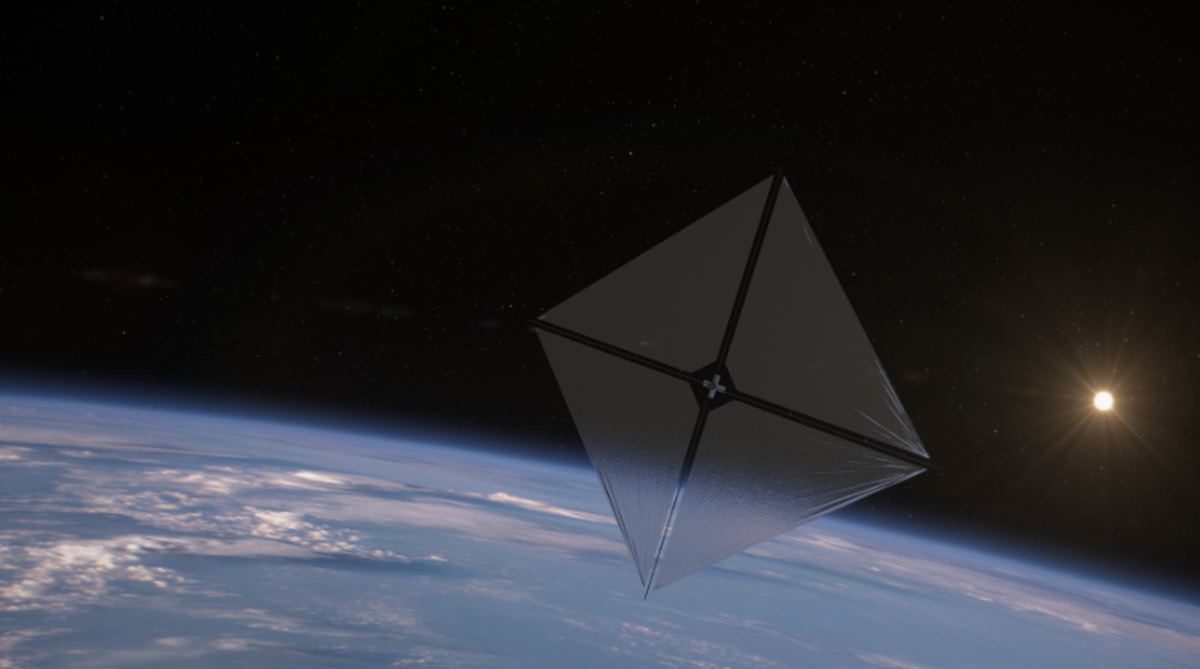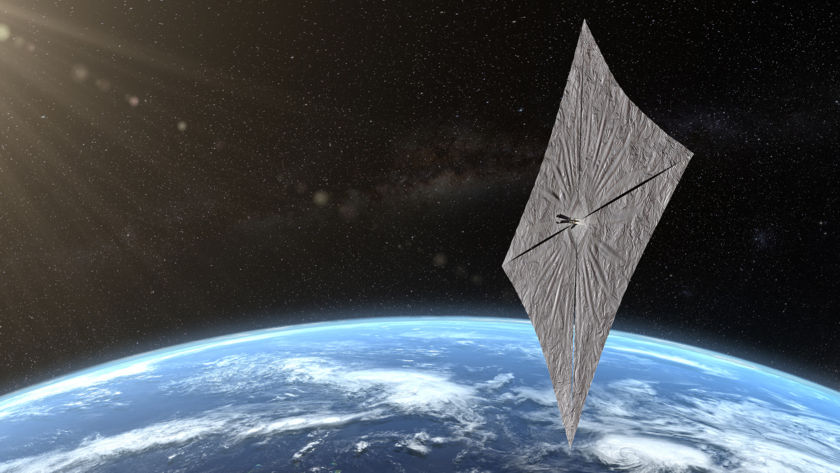The Breakthrough Starshot program aims to cross the immense distances to the nearest star in just decades. Using a high-powered laser to propel a reflective sail technology to relativistic speeds is their mission. The selection of sail material is key to its success as it must be lightweight while being able to withstand acceleration and radiation from the laser. A recent study explores various materials and proposes that core-shell structures—spherical particles composed of two different materials—could be a promising solution.
Continue reading “What Should Light Sails Be Made Out Of?”NASA’s Next Solar Sail is About to Go to Space

Everyone knows that solar energy is free and almost limitless here on Earth. The same is true for spacecraft operating in the inner Solar System. But in space, the Sun can do more than provide electrical energy; it also emits an unending stream of solar wind.
Solar sails can harness that wind and provide propulsion for spacecraft. NASA is about to test a new solar sail design that can make solar sails even more effective.
Continue reading “NASA’s Next Solar Sail is About to Go to Space”What a Swarm of Probes Can Teach Us About Proxima Centauri B

You’ve likely heard of the Breakthrough Starshot (BTS) initiative. BTS aims to send tiny gram-scale, light sail picospacecraft to our neighbour, Proxima Centauri B. In BTS’s scheme, lasers would propel a whole fleet of tiny probes to the potentially water-rich exoplanet.
Now, another company, Space Initiatives Inc., is tackling the idea. NASA has funded them so they can study the idea. What can we expect to learn from the effort?
Continue reading “What a Swarm of Probes Can Teach Us About Proxima Centauri B”Photonic Crystals Could Be Exactly What Breakthrough Starshot is Looking For

Light sail technology is a fascinating concept and a step change in rocket propulsion. It may not be big and impressive like the Saturn V, the Space Shuttle or the new Starship rocket but when it comes to travelling among the stars, light sails could just be the answer. And what better material to build the sails from then something that just makes me want to say it over and over again….I talk about photonics crystals. It’s sounds right out of a Star Trek episode but a new paper examines their feasibility.
Continue reading “Photonic Crystals Could Be Exactly What Breakthrough Starshot is Looking For”Birds use Dynamic Soaring to Pick Up Velocity. We Could Use a Similar Trick to Go Interstellar
To stand on a coastal shore and watch how eagles, ravens, seagulls, and crows take flight in high winds. it’s an inspiring sight, to be sure. Additionally, it illustrates an important concept in aerial mechanics, like how the proper angling of wings can allow birds to exploit differences in wind speed to hover in mid-air. Similarly, birds can use these same differences in wind speed to gain bursts of velocity to soar and dive. These same lessons can be applied to space, where spacecraft could perform special maneuvers to pick up bursts of speed from “space weather” (solar wind).
This was the subject of a recent study led by researchers from McGill University in Montreal, Quebec. By circling between regions of the heliosphere with different wind speeds, they state, a spacecraft would be capable of “dynamic soaring” the same way avian species are. Such a spacecraft would not require propellant (which makes up the biggest mass fraction of conventional missions) and would need only a minimal power supply. Their proposal is one of many concepts for low-mass, low-cost missions that could become interplanetary (or interstellar) explorers.
Continue reading “Birds use Dynamic Soaring to Pick Up Velocity. We Could Use a Similar Trick to Go Interstellar”Laser-Powered Sails Would be Great for Exploring the Solar System too
Between the exponential growth of the commercial space industry (aka. NewSpace) and missions planned for the Moon in this decade, it’s generally agreed that we are living in the “Space Age 2.0.” Even more ambitious are the proposals to send crewed missions to Mars in the next decade, which would see astronauts traveling beyond the Earth-Moon system for the first time. The challenge this represents has inspired many innovative new ideas for spacecraft, life-support systems, and propulsion.
In particular, missions planners and engineers are investigating Directed Energy (DE) propulsion, where laser arrays are used to accelerate light sails to relativistic speeds (a fraction of the speed of light). In a recent study, a team from UCLA explained how a fleet of tiny probes with light sails could be used to explore the Solar System. These probes would rely on a low-power laser array, thereby being more cost-effective than similar concepts but would be much faster than conventional rockets.
Continue reading “Laser-Powered Sails Would be Great for Exploring the Solar System too”If Launched by 2028, a Spacecraft Could Catch up With Oumuamua in 26 Years
In October 2017, the interstellar object ‘Oumuamua passed through our Solar System, leaving a lot of questions in its wake. Not only was it the first object of its kind ever to be observed, but the limited data astronomers obtained as it shot out of our Solar System left them all scratching their heads. Even today, almost five years after this interstellar visitor made its flyby, scientists are still uncertain about its true nature and origins. In the end, the only way to get some real answers from ‘Oumuamua is to catch up with it.
Interestingly enough, there are many proposals on the table for missions that could do just that. Consider Project Lyra, a proposal by the Institute for Interstellar Studies (i4is) that would rely on advanced propulsions technology to rendezvous with interstellar objects (ISOs) and study them. According to their latest study, if their mission concept launched in 2028 and performed a complex Jupiter Oberth Manoeuvre (JOM), it would be able to catch up to ‘Oumuamua in 26 years.
Continue reading “If Launched by 2028, a Spacecraft Could Catch up With Oumuamua in 26 Years”Want the Fastest Solar Sail? Drop it Into the Sun First
In the coming decades, multiple space agencies plan to return astronauts to the Moon (or to send them there for the first time) and mount the first crewed missions to Mars. Between that and the explosive growth we are seeing in Low Earth Orbit (LEO), there is no doubt that we live in an era of renewed space exploration. It’s therefore understandable that old and new concepts for interstellar travel are also being considered these days.
Right now, a considerable focus is on light sails that generate their own propulsion by radiation pressure or are accelerated by lasers. These concepts present all kinds of technical and engineering challenges. Luckily, Coryn Bailer-Jones of the Max Planck Institute for Astronomy (MPIA) recently conducted a study where he argues for a “Sun Diver” light sail that will pick up all the speed it needs by diving close to the Sun.
Continue reading “Want the Fastest Solar Sail? Drop it Into the Sun First”What’s the Best Way to Sail From World to World? Electric Sails or Solar Sails?
In the past decade, thousands of planets have been discovered beyond our Solar System. This has had the effect of renewing interest in space exploration, which includes the possibility of sending spacecraft to explore exoplanets. Given the challenges involved, a number of advanced concepts are currently being explored, like the time-honored concept of a light sail (as exemplified by Breakthrough Starshot and similar proposals).
However, in more recent years, scientists have proposed a potentially more-effective concept known as the electric sail, where a sail composed of wire mesh generates electrical charges to deflect solar wind particles, thus generating momentum. In a recent study, two Harvard scientists compared and contrasted these methods to determine which would be more advantageous for different types of missions.
Continue reading “What’s the Best Way to Sail From World to World? Electric Sails or Solar Sails?”Planetary Society’s Light Sail 2 is Set to Launch on a Falcon Heavy Rocket Next Month

The Planetary Society is going to launch their LightSail 2 CubeSat next month. LightSail 2 is a test mission designed to study the feasibility of using sunlight for propulsion. The small satellite will use the pressure of sunlight on its solar sails to propel its way to a higher orbit.
Continue reading “Planetary Society’s Light Sail 2 is Set to Launch on a Falcon Heavy Rocket Next Month”



